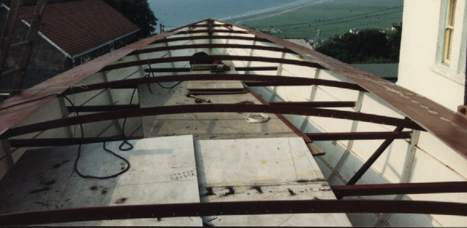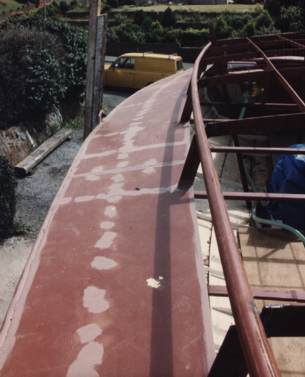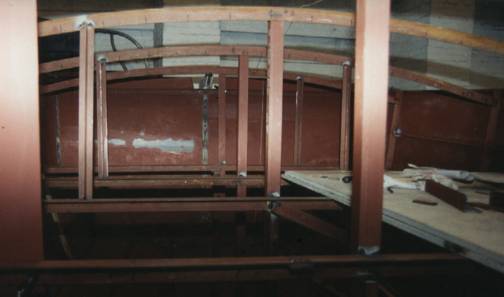Links
Fay Marine Photographs 7

Deck beams in position and side decks in place. This yacht has a coachroof so once the deck beams are in position the side deck stringers are fitted and then the side deck plates are laid.
The whole shape including the coachroof can be formed first, however it is generally easier to make it in two stages.
At this point temporary supports from the headstocks to the frames at the inner edge are fitted and the central part of the deck beams cut away.
On some designs the cut section of the beams need to be re-bent to give more headroom. This is not needed on a flush deck yacht.
On a flush deck all the stringers will be fitted and the whole deck plated, which is a remarkably quick process.

After fitting temporary supports the deck beams have been cut at the inside edge of the side deck, the coachroof side frame pieces have been welded into position. These are normally all at the same angle so a spirit level with either an adjustable bubble or a template cut to the required angle can be used to ensure they are all correct.
The deck beams are then fitted and temporarily supported. The notches for the stringers are cut, preferably with an angle grinder to minimise distortion, and the stringers laid in place.
This yacht uses tube for the edge of the deck and coachroof which is a little more work but well worth the effort to form a rounded edge which not only looks better than a sharp corner but will hold the paint better if it is knocked.
With the deck projecting around 2" (50mm) inside the edge of the coachroof this makes an incredibly strong joint. At the lower end of each section a drain hole will need drilling to ensure there is nowhere for condensation to collect.

Deck beams on a flush deck yacht. The pre drilled holes can be seen. If these are accurately measured and drilled before the bar is bent they can be used as the marks at which to make each bend.
I mark every 6" (150mm) and bend at these points. The bar is of course a series of short flats which in fact are totally unnoticeable.
These deck beams are over 12ft (4 meters) long and need four supports to the headstocks to stop them flattening when the deck is plated. The supports are pieces of scrap angle or T bar.
ŠPaul Fay 2004